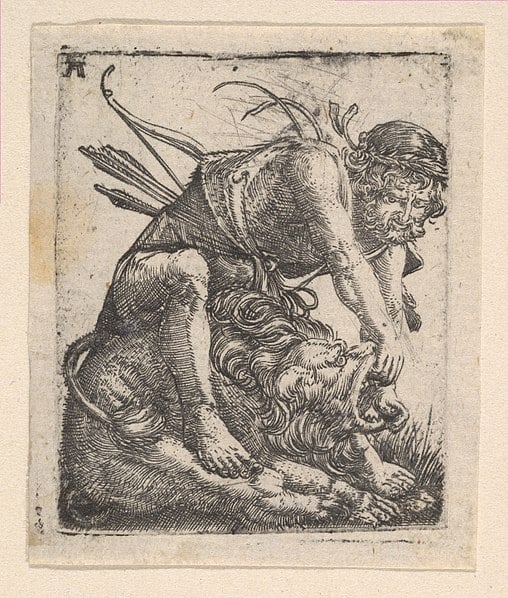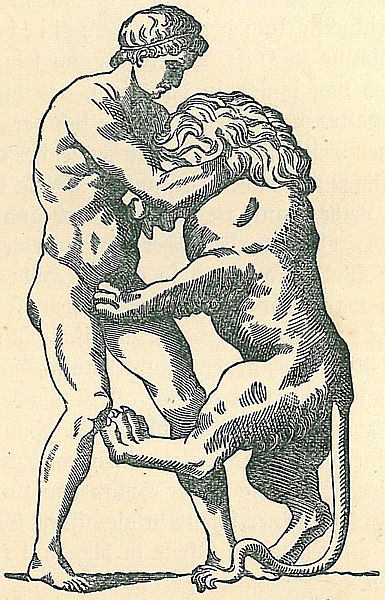In the vast tapestry of Greek mythology, the Nemean Lion stands out as one of the most formidable monsters ever faced by a hero. Its invulnerability and fierce nature made it a challenge even for the strongest of warriors. This article delves into the origins, tales, and significance of this legendary beast.
Nemean Lion Key Facts
| Origin | Nemea, Greece |
| Creator | Some say Zeus, others Typhon and Echidna |
| Defeated by | Heracles (Hercules in Roman) |
| Habitat | Nemean forest |
| Other names | None known |
| Roman name | Same as Greek |
| Associated with | The Twelve Labors of Heracles |
| Symbols | Golden fur, impenetrable skin |
Name and Etymology
The name “Nemean Lion” is derived from its dwelling place, the Nemean forest, located in the Peloponnese region of Greece. The term “Nemean” itself is believed to be pre-Greek, suggesting that the legend of this beast might predate classical Greek myths.
There isn’t a distinct Roman name for the Nemean Lion, as its tale is primarily rooted in Greek tradition. While there aren’t many epithets or alternative names for the creature, its reputation is unmistakably recognized by its association with Heracles’ first labor.
Nemean Lion Origin and Creation
Some sources suggest that it was a direct offspring of the monstrous Typhon, The Cataclysmic Force of Greek Mythology and Echidna, The Mother of Monstrous, making it a sibling to other notorious creatures like the Chimera and the Lernaean Hydra. This lineage would explain its supernatural strength and invulnerability.
The lion’s impenetrable golden fur made it immune to mortal weapons, a trait that added to its legendary status. Its creation, whether by divine design or monstrous birth, served a purpose: to challenge and test the might of heroes, most notably Heracles.

Encounters and Conflicts
The most famous encounter with the Nemean Lion is undoubtedly its confrontation with Heracles. As the first of his Twelve Labors, Heracles was tasked with slaying the beast. The lion’s skin was impervious to any weapon, rendering arrows and swords useless.
After realizing this, Heracles engaged the lion in a fierce hand-to-hand combat inside its cave, eventually strangling it to death. This victory not only marked the beginning of Heracles’ redemption journey but also provided him with the lion’s skin, which he wore as an impenetrable armor.
Depiction And Characteristics
The Nemean Lion is often depicted as a massive lion with shimmering golden fur. Its eyes are usually shown as fierce and glowing, a testament to its predatory nature and supernatural origins. The most distinguishing feature, however, is its impenetrable skin, which no weapon could pierce.
The lion’s nature was that of a relentless predator. It terrorized the region of Nemea, with its strength and invulnerability making it an apex predator. Its behavior, as described in myths, showcases a creature that was both majestic and terrifying.
Its primary ability, apart from its immense strength, was its invulnerable hide. This made it a unique challenge for Heracles, as traditional combat methods proved ineffective. The lion’s prowess wasn’t just physical; its reputation also played a psychological role, instilling fear in those who dared to confront it.
Symbols or Associations
The Nemean Lion, in its essence, symbolizes insurmountable challenges or obstacles. Its golden, impenetrable fur represents both a literal and metaphorical barrier that needs to be overcome. After defeating the lion, Heracles wearing its skin symbolized not only protection but also the triumph of man’s wit and strength over seemingly impossible odds.
Myths about the Nemean Lion
The lion was not just a mere beast; it was a creature of divine origin, its golden fur impenetrable to mortal weapons, and its roar echoing the wrath of the gods. Its reign of terror in the Nemean region was not just a threat to the people but also a challenge set forth to test the mettle of heroes.
Outsmarting the lion
The lion’s encounter with Heracles is a central episode in the Twelve Labors, a series of challenges set upon the hero as penance for his past misdeeds. Tasked with slaying the beast, Heracles soon realized that his arrows and club were ineffective against the lion’s hide. The battle between them was not just of strength but also of wits. Heracles, in a display of both bravery and intelligence, lured the lion into a cave with two entrances.
He blocked one entrance and confronted the beast from the other, engaging it in a fierce hand-to-hand combat. Using his immense strength, he strangled the lion, turning its invulnerability against it. This victory was not just a physical triumph but also a symbolic one, showcasing man’s ability to overcome divine challenges through wit and will.
Following its defeat, the Nemean Lion’s legacy did not fade. Heracles skinned the creature, using its own razor-sharp claws to cut through the hide. He then wore its skin as a cloak, a symbol of his victory and a testament to his strength. This cloak, impenetrable and majestic, served as both protection and a reminder of his first labor. The tale of the Nemean Lion and Heracles is more than just a battle; it’s a narrative of resilience, intelligence, and the age-old conflict between man and the divine challenges set before him.

Representations Of Nemean Lion In Art
Vase paintings, sculptures, and mosaics often depict the intense struggle between man and beast, with Heracles usually shown in the act of grappling the lion, highlighting the raw physicality of their encounter. The image of Heracles wearing the lion’s skin became an iconic representation of the hero, symbolizing his victory and protection.
Mentions in Ancient Texts
The Nemean Lion is mentioned in various ancient texts, most notably in the works of Apollodorus and Pindar. In Apollodorus’ “Bibliotheca,” the tale of Heracles and the lion is detailed, emphasizing the creature’s invulnerability and Heracles’ ingenuity in defeating it. A quote from Pindar’s “Nemean Ode” reads: “He who faced the Nemean beast, whose eyes flashed fire, and by the will of Zeus brought it to its end.”
Frequently Asked Questions
No, the Nemean Lion is a mythical creature from ancient Greek legends, symbolizing insurmountable challenges.
Heracles strangled the lion after realizing that its skin was impervious to weapons.
He skinned the lion using its own claws and wore its hide as armor, which was impenetrable.
The lion resided in the Nemean forest in the Peloponnese region of Greece.
Some myths suggest the lion was the offspring of Typhon and Echidna.
The lion’s hide was a divine or monstrous trait, making it immune to all mortal weapons.
Featured Image Credit: Francisco de Zurbarán, Public domain, via Wikimedia Commons
